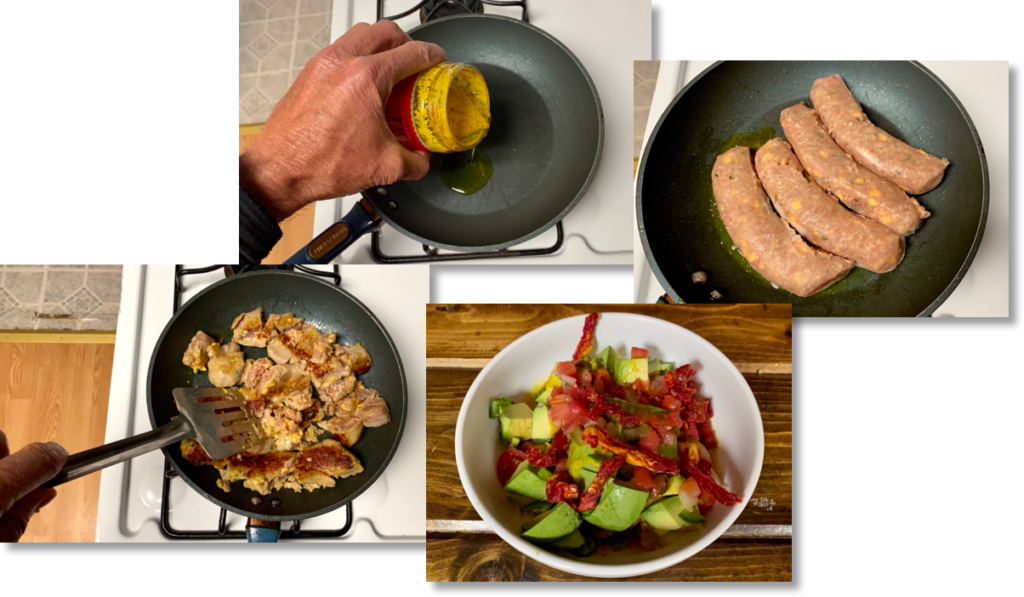I’m just back from a coast-to-coast cross country car/bike trip (advocating safe streets for all – more later) and love being on the road for the terrific sights, “big smile” interesting people I meet and the fun of improvising meals on the fly.
Along the way, I picked up some fresh, homemade jalapeño cheddar sausage at a small meat market in a tiny Kansas town. Before buying the sausages, I checked the ingredients.
At the time, all looked fine, though seeing maltodextrin pricked up my ears. Still, I ended up having a blast putting together a very flavorful sausage, fresh vegetable and cheese dinner bowl. As you can see in the top left picture below, I used fresh salad dressing I’d made earlier on my trip to substitute for oil that wasn’t available in my Airbnb for the night before cooking the sausages in the pan.
Later, I looked up maltodextrin. To cut to the chase, maltodextrin is a highly processed food additive made from vegetable starch and used in lots of processed foods to preserve and improve the texture/mouth feel of those processed foods. I stressed “processed foods” in that last sentence because, as noted in Medical News Today, “if a person eats too many products that contain maltodextrin, their diet is likely to be high in sugar, low in fiber, and full of highly processed foods.” (Medical News Today: https://www.medicalnewstoday.com/articles/322426#which-foods-contain-maltodextrin). For what that means to you, please see the last paragraph below.
For a deeper dive, here are some bullets and links about what Maltodextrin is, foods that contain it and some potential health risks:
- Maltodextrin is a polysaccharide that is used as a food ingredient.[2] It is produced from vegetable starch by partial hydrolysis and is usually found as a white hygroscopicspray-dried powder.[1] Maltodextrin is easily digestible, being absorbed as rapidly as glucose and may be either moderately sweet or almost flavorless (depending on the degree of polymerisation).[2] It can be found as an ingredient in a variety of processed foods.[2] (Wikipedia (and confirmed by other sources): https://en.wikipedia.org/wiki/Maltodextrin)
- Maltodextrin is a highly processed food product made from corn, rice, potato starch, or wheat (again, the key words are “highly processed”, which should always give you pause) and is considered safe for human consumption as noted by the FDA (US Food and Drug Administration): “the ingredient is used in food with no limitation other than current good manufacturing practice” : (https://www.accessdata.fda.gov/scripts/cdrh/cfdocs/cfcfr/cfrsearch.cfm?fr=184.1444)
- Here is a partial list of foods, also from Medical News Today and other sources, that can contain maltodextrin, all of which are processed foods:
- pasta, cooked cereals, and rice
- meat substitutes
- baked goods
- salad dressings
- frozen meals
- soups
- sugars and sweets
- energy and sports drinks
- There is also unconfirmed speculation that maltodextrin, as a highly processed sugar, might play a part in decreasing good, healthy gut bacteria and encouraging the growth of harmful bacteria that can lead to intestinal inflammation and problems like IBD (Irritable Bowel Disorder). Regular table sugar can have that seem effect. (Personally, I had painful intestinal inflammation years ago, mostly due to mismanaged stress, that has been much improved by managing stress better and being vigilant about what I eat and drink.)
Bottom line, I ate and enjoyed the meals I made with the jalapeño cheddar sausages shown above. At the same time, after knowing what I know now, I’ll sure keep an eye out for maltodextrin and try to avoid it when I can – without making myself crazy (ha!).
But what about you? As I advocate regularly here, the key to eating life-promoting well is eating fresh unprocessed/minimally processed foods and always with full-on flavor – flavor ALWAYS rules – and I’m glad to help you with that right here!

 June 9th, 2023
June 9th, 2023  brucetretter
brucetretter 


 Posted in
Posted in  Tags:
Tags: